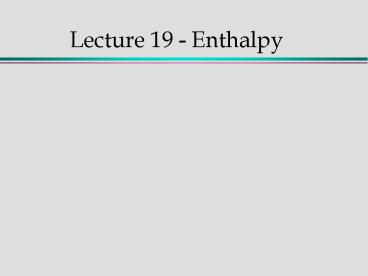Lecture 19 Enthalpy PowerPoint PPT Presentation
1 / 32
Title: Lecture 19 Enthalpy
1
Lecture 19 - Enthalpy
2
There are 3 ways to find DH
- 1. Measure it in the lab
- 2. Use Hess law
- 3. Use enthalpies of formation
3
Enthalpies of Formation
- Standard Enthalpy of Formation
- DHfo
standard state
formation
4
Enthalpies of Formation
- DHfo is the hypothetical DH for formation of one
mole of a compound in its standard state from the
elements in their standard states
5
Standard States
- defined at 25oC, 1 atm pressure
- e.g. C graphite
- O2 O2(g)
- CO2 CO2(g)
- H2O H2O(l)
- Zn2(aq) 1 M Zn2(aq)
6
by definition,
- DHfo for an element in its standard state 0
7
for example,
- DHfo (CO2(g)) is DH for the reaction
- C(s) O2(g) CO2(g)
8
for example,
- DHfo (CO2(g)) is DH for the reaction
- C(s) O2(g) CO2(g)
graphite
gases at 1 atm pressure, 25oC
9
- DHfo (CO(g)) is DH for the reaction
- C(s) ½ O2(g) CO(g)
- DHfo (CH3OH(l)) is DH for the reaction
- C(s) ½ O2(g) 2 H2(g) CH3OH(l)
- DHfo (Al2O3(s)) is DH for the reaction
- 2 Al(s) 3/2 O2(g) Al2O3(s)
10
some examples of DHfo (kJ/mol)
- Ca(s) 0
- CaO(s) -635.1
- CaCO3(s) -1206.9
- N2(g) 0
- NH3(g) -45.9
- NO(g) 90.2
11
e.g. The Thermite Reaction
- Fe2O3(s) 2 Al(s) 2 Fe(s) Al2O3(s)
- 2 Al(s) 3/2 O2(g) Al2O3(s) (rxn 1)
- DH DHfo (Al2O3(s))
- 2 Fe(s) 3/2 O2(g) Fe2O3(s) (rxn 2)
- DH DHfo (Fe2O3(s))
12
According to Hess
- 2 Al(s) 3/2 O2(g) Al2O3(s) (rxn 1)
- Fe2O3(s) 2 Fe(s) 3/2 O2(g) (- rxn 2)
- Fe2O3(s) 2 Al(s) 2 Fe(s) Al2O3(s)
- DH DHfo (Al2O3(s)) -DHfo (Fe2O3(s))
13
DH DHfo (Al2O3(s)) -DHfo (Fe2O3(s))
- -1675.7 - (-821.4)
- -854.3 kJ mol-1
14
In general,
- DHreaction
- S(np DHfo,p) - S(nr DHfo,r)
stoichiometric coefficient
sum of
15
for example,
- find DH for the reaction
- 2 H2S(g) 3 O2(g) 2 SO2(g) 2 H2O(g)
- DH 2 DHfo (SO2(g)) 2 DHfo (H2O(g))
- -
- 2 DHfo (H2S(g)) 3 DHfo (O2(g))
16
- (2 x (-296.8) 2 x (-241.8))
- -
- (2 x (-20.2) 3 x (0))
- -1036.8 kJ/mol
17
another example...
- NaOH(s) Na(aq) OH-(aq)
- DH DHfo (Na(aq)) DHfo (OH-(aq))
- -
- DHfo (NaOH(s))
18
- - 239.4 (- 229.7) - (- 426.3)
- - 42.8 kJ/mol
- (exothermic, as observed)
19
another example...
- NH4Cl(s) NH4(aq) Cl-(aq)
- DH DHfo (NH4(aq)) DHfo (Cl-(aq))
- -
- DHfo (NH4Cl(s))
20
- -132.7 (-167.3) - (-315.1)
- 15.1 kJ/mol
- (endothermic, as observed)
21
Another endothermic reaction...
- Ba(OH)2 8 H2O(s) 2 NH4NO3(s)
- ?
- Ba(NO3)2(s) 2 NH3(aq) 10 H2O(l)
water of hydration
22
Where do the DHfo values come from?
- e.g. find DHfo CH3OH(l)
- CH3OH(l) 3/2 O2(g) CO2(g) 2 H2O(g)
- 1. DHorxn from calorimetry -638.5 kJ/mol
- 2. DHorxn DHfo (CO2(g)) 2 DHfo (H2O(g))
- - DHfo (CH3OH(l))
23
- 3. Thus, DHfo (CH3OH(l))
- - DHorxn DHfo(CO2(g)) 2 DHfo(H2O(g))
- 638.5 (-393.5) 2(-241.8)
- -238.6 kJ/mol
24
another example
- How much energy can the body obtain from 1 g
glucose (a carbohydrate)? - food glucose (during digestion)
- glucose energy (via metabolism)
a very complicated mechanism!
25
- glucose energy has the overall reaction
- C6H12O6(s) 6 O2(g) 6 CO2(g) 6 H2O
- DHo -2803 kJ/mol
- -15.6 kJ/g
26
Eating too much fat?
- A typical fat is glycerol trilaurate
- C39H74O6(s) 54.5 O2(g) 39 CO2(g) 37 H2O
- DHo -23900 kJ/mol
- -37.4 kJ/g
27
The next time you go to class in Dunton Tower...
- Use the stairs!
- 70 kg x 100 m x 9.8 m s-2
- 68,600 J
- (68.6 kJ)
- (youll burn off less than 2 g of fat)
28
Why IS heat released or absorbed?
- Breaking bonds requires energy.
- Making bonds gives energy back.
- DH DH bonds broken DH bonds formed
DH gt 0
DH lt 0
29
- Bond Dissociation Energies
- e.g. H-H H H
- DH DH-H 436 kJ/mol
30
- e.g. find DH for the reaction
- ½ N2(g) 3/2 H2(g) NH3(g)
31
- ½ N2(g) N(g) (rxn 1)
- DH ½ (DN-N)
- 3/2 H2(g) 3 H(g) (rxn 2)
- DH 3/2 (DH-H)
- N(g) 3 H(g) NH3(g) (rxn 3)
- DH - 3 (DN-H)
32
- rxn 1 rxn 2 rxn 3
- ½ N2(g) 3/2 H2(g) NH3(g)
- DH - 3(DN-H) ½ (DN-N) 3/2 (DH-H)
- - 3(389) ½ (946) 3/2 (436)
- - 40 kJ/mol
- (actual is -46.1 kJ/mol)

